How to Measure Sales Training ROI (Examples & Best Practices)

When it comes to measuring sales training ROI, most advice is either self-explanatory or ambiguous, such as “decide what success looks like” or “set expectations for your training.” However, in our 20+ years of working with companies like Zoom, Samsung, and Nike, we found there are concrete best practices and tools that successful sales teams use to measure their training’s return on investment.
The most important piece of the puzzle is being able to track each sales rep’s training progress and their key performance indicators (KPIs) in one place. Without this ability, you’ll spend hours manually switching between platforms and aggregating data.
That’s why we start this post with detailed examples of how to use our sales enablement platform — Brainshark, a Bigtincan company — to track all of the information needed to measure sales training ROI in one place. Then, we’ll discuss the specific metrics you can track, as well as several best practices for calculating sales training ROI.
In this post, we cover:
- Tracking reps’ training progress and sales KPIs in one dashboard.
- How to choose which metrics to track (leading vs. lagging indicators).
- Setting a baseline for sales training success.
- How to determine the value of your sales training efforts.
- How to improve ROI by creating professional trainings quickly and efficiently.
Book a free Brainshark demo to see how our platform can help you prepare your sales teams to perform at the highest level.
Track reps’ training progress and sales KPIs in one dashboard
In general, calculating the ROI of your sales training requires answering three questions:
- What are the results of your sales training program?
- What are these results worth to your organization?
- How much does it cost to create and maintain your training?
The first few sections of this article focus on how to answer the first question. Then, we’ll move on to the last two questions.
To answer the first question, you need to be able to directly attribute certain events (such as an increase in closed deals) to specific trainings.
The only way to do this is by monitoring all reps’ training information (e.g., completed courses, quiz scores) alongside their sales KPIs(e.g., open deals and generated pipeline) in one place.
The problem with this is that data is usually siloed off in different platforms. As a result, you have to pull each rep’s training progress data and sales KPIs from multiple sources, create new dashboards or spreadsheets, and continuously update them. All of this back and forth requires a lot of manual work, making the process incredibly time-consuming.
Instead, Brainshark’s readiness scorecards let you monitor the training progress of individual reps and teams in one easy-to-read report.
Additionally, with our CRM and Salesforce integrations, you can track the sales KPIs that are important to your organization (open deals, pipeline, closed deals, etc.) right alongside reps’ training performance.
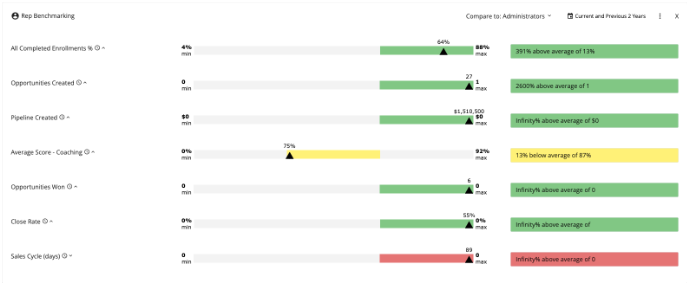
For example, say you want to evaluate the ROI of your onboarding training specifically. In that case, it would make sense to look at metrics like time to competency or time to first deal to see how quickly reps ramp up.
With readiness scorecards, these onboarding metrics can appear right next to each rep’s training progress. Then, once reps are past the onboarding phase, you could add your other sales KPIs — meetings set, pipeline, open deals, etc. — to gauge the impact and ROI of your continuous training initiatives.
Readiness scorecards can be customized to provide whatever information you need.
How to choose which metrics to track (leading vs. lagging indicators)
When it comes to choosing which metrics to track, it’s essential to distinguish between leading and lagging indicators.
Leading indicators are directly attributable to specific actions taken such as following reps’ ongoing training and sales performance, which can help you gauge their chances for future success.
Here are a few examples of leading indicators:
- Training progress metrics (course completions, quiz scores, etc.)
- Time to proficiency
- Number of meetings
- Call-to-meeting ratios
- Time to first deal
- Number of open deals
The biggest benefit of using leading indicators is that you get key information earlier — instead of waiting weeks or months to see if reps start closing deals.
Conversely, lagging indicators are less attributable to specific actions and often report on reps’ performance after the fact (i.e., after a specific event like the end of the quarter or year). Closed deals are a classic lagging indicator. They report on the most important goal for salespeople (generating revenue) but you have to wait weeks or months to get them. Sales cycle length and quota goals are other examples of lagging indicators.
We recommend tracking a mix of both leading and lagging indicators.
While lagging indicators are generally the best way to view the impact of training on your bottom line, leading indicators give you a forecast of the final result. This allows you to adjust training efforts as necessary to achieve better final results.
One of the best leading indicators is how well reps perform in coaching assignments.
The best leading indicator of success: coaching assignment results
While training course completions and quiz answers are important leading indicators, they have some blind spots. Specifically, they can’t tell you if reps can actually apply what they’ve learned during their training in the field.
To overcome this limitation, Brainshark’s sales coaching activities allow sales managers to see how reps would do in a real-life client conversation.
Here’s how:
You start by creating an assignment for reps. For example, the assignment can be to record a 3-minute video in which they pitch your product to a specific type of customer and overcome a common objection. Then, reps can record a video from within the Brainshark platform or upload an external recording they took with their phone (or another recording device).
Once submitted, the recording is analyzed by our AI-powered engine, which answers questions like:
- What filler words did the rep use and how often?
- Which emotions did their facial expressions portray?
- How fast were they talking and was their message clear based on the level of speech they used?
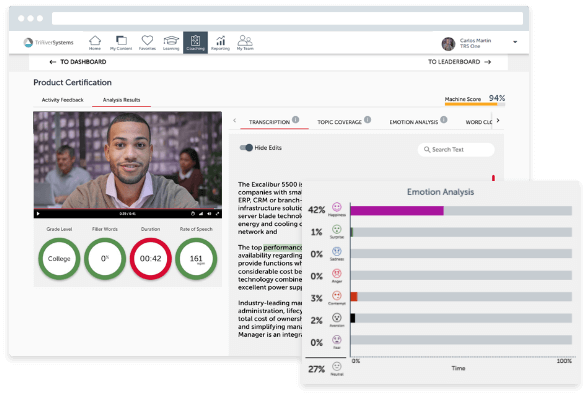
Reps can also send their recording to their peers for feedback before sending it to their sales leader. This is a great way to encourage peer learning and ensure managers get a more polished final version since they aren’t the first ones providing feedback.
Then, the final evaluator can use all of this feedback to see who needs the most coaching and in what areas. This helps evaluators prioritize and maximize their time effectively.
Since coaching challenges mirror what reps have to do in real-life situations, they’re a great leading indicator for future success.
You can estimate the coaching’s impact on sales results alongside all other training progress and sales KPIs to predict the future ROI of the coaching assignment.
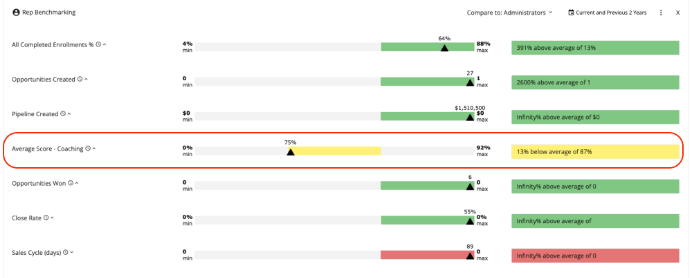
Coaching assignments are very useful for keeping training content fresh in the reps’ mind, therefore increasing effectiveness.
You may give reps the perfect training content but it won’t do much good if they don’t remember the training when they actually need it. Giving coaching assignments at regular intervals ensures reps are ready to sell at any moment.
Setting a baseline for sales training success
Once you have your metrics (and a single place to track them), it’s time to set a baseline for your training efforts. Setting a baseline lets you objectively compare results, instead of relying on impressions.
For example, you may have a rep who feels like they’ve mastered the sales pitch because of the coaching challenges they took. Their sales are up this quarter, so it looks like the coaching is the reason for their results. However, this information doesn’t prove that their success was directly related to the coaching. Tons of other reasons may have resulted in their good quarter such as a good market, entering a new territory, etc.
Contrast that with the following example:
You have ten reps that closed the same amount of deals in the first quarter. During the second quarter, five of the reps are assigned additional coaching challenges on handling objections, while the other five aren’t. After the second quarter, you see that reps who completed the additional coaching challenges closed more deals. Those who didn’t complete the coaching assignments didn’t show an improvement in closed deals even though they were generating equal pipeline. This second example provides a much more reliable conclusion about the effectiveness of the coaching.
There are several ways to set a baseline and you’ll often need more than one baseline.
Here are a few practical ways to set a baseline and evaluate the impact of your training:
- Historical baseline. As mentioned in the example above, you could look at things like 1st quarter sales performance vs. 2nd quarter sales performance for reps or entire teams. This method relies on you already having some historical data, which is often collected in tools like Salesforce or Gong (both of which can be integrated with Brainshark).
- A/B testing. A/B tests are randomized experiments with two variants: A and B. In the context of sales training, the two variants might be different reps or entire teams. For example, if you have two sales teams that sell the same product to the same customer base, you can assign a specific coaching challenge to just one of them as an A/B test. Once you have each team’s sales results, you can gauge the effectiveness of the challenge. This is a good option if you don’t have any recorded historical data.
- Industry standards. If you have access to data on things like average onboarding times, closed deals, or generated revenue per rep in your industry, you could use that as your baseline. This isn’t the best option, as it’s not specific to your business. But sometimes it’s necessary to use industry standards when there’s no internal data to lean on.
How to determine the value of your sales training efforts
Most companies focus entirely on closed deals when determining the value of sales training. However, there are many other quantifiable metrics to consider such as turnover rate or ramp-up time.
Non-quantifiable factors, like message consistency or reps’ confidence and job satisfaction, also need to be taken into account.
In the next sections, we’ll show you how to approach ROI calculations for quantifiable metrics and what to do for the non-quantifiable ones.
Quantifiable metrics
When working with quantifiable metrics, calculating ROI is relatively straightforward.
For example, say you have 10 reps that started work at the same time. A few months later, you see that four of them took two weeks less to ramp up than the rest. Their training progress data shows they completed two specific modules that their colleagues didn’t. If these trainings help reduce the time to productivity by two weeks, you can estimate how much that’s worth to your business, based on:
- The number of reps you onboard during a specific period.
- How many additional deals they can close when they’re onboarded faster.
You could go through the same exercise with all other KPIs that are relevant to your business — time to first deal, pipeline, revenue targets, etc. Of course, this won’t be a perfectly accurate calculation, as factors outside of the training can also influence results. However, it’s still a very good indicator that your training efforts are moving the needle.
Intangible results
One of the things that make calculating sales training ROI so tricky is that there are a lot of results you can’t really put a price on. These are things like reps’ engagement and confidence after their training or message consistency across teams.
While these factors are intangible, you can make educated guesses and use anecdotal evidence to get a sense of how your training impacts them.
Let’s take message consistency as an example. There are two questions you can ask when evaluating this factor:
- What is message consistency worth to your organization?
- How much will it cost you if your messaging is inconsistent across sales teams?
You can assess reps’ message consistency with conversational intelligence software like Gong. Additionally, you could assign reinforcement training only to certain team members (i.e., A/B test the training effectiveness) and see whether it leads to better message consistency and improved sales KPIs.
Again, it may not be possible to put an accurate dollar value on this assessment. But when you know your training is moving things in the right direction, you can at least estimate how much its impact is worth.
How to improve ROI by creating professional trainings quickly and efficiently
One problem that often reduces ROI is the cost of creating training materials, particularly video trainings. It typically takes specialized skills and several hours to create training materials.
Brainshark solves that problem by letting anyone quickly create interactive, video-based training content, without needing advanced technical skills.
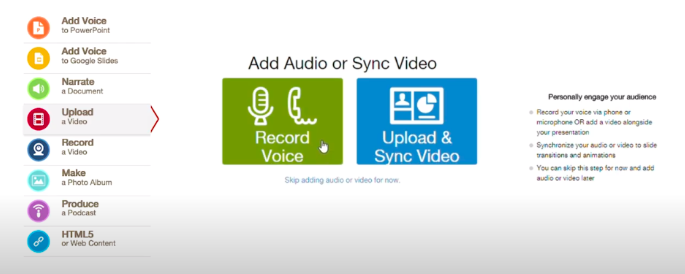
The process of creating training content with Brainshark is simple. You upload a PowerPoint, Slide, or other documents that your teams already have. Then, you add various interactive elements such as hyperlinks, branched pathways, and much more.
You can also record your screen along with video or audio to give the presentation a personalized experience. Again, this doesn’t require any specialized skills or tons of time, so the cost of building and maintaining your training is much lower.
Once uploaded, Brainshark trainings are available online and offline, and on nearly any device. Plus, Brainshark courses are automatically SCORM compliant, so you can access them on our platform or upload them to your LMS.
We’ve gone over the process of creating a comprehensive sales training program in other articles, so we won’t cover all the details here. If you’re interested, check out our article on building a tailor-made sales elearning program.
One important capability that’s worth mentioning here is adding voiceovers to training materials. Getting respected sales professionals and other subject-matter experts (SMEs) to narrate your training ensures that learners actually trust the person delivering the content. This improves reps’ engagement and retention, which positively impacts their performance — and your training’s ROI.
With Brainshark, anyone can easily add voiceover to training material in just a few minutes.
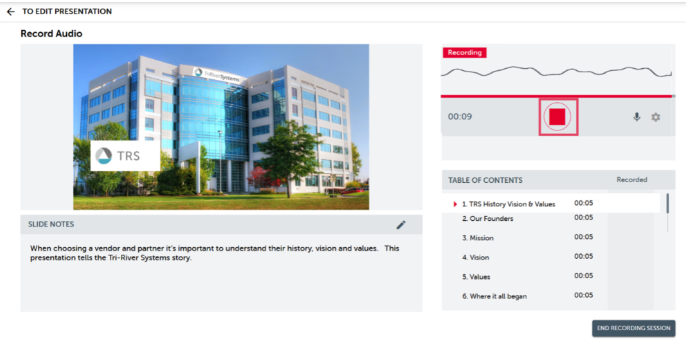
You can create an audio recording directly within Brainshark or upload a separate file. Then, you can sync the audio file to the presentation, add notes, manage volume, and more.
If you want to measure and improve your sales training’s ROI, book a free demo of Brainshark.

